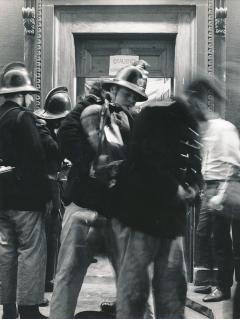5. Firemen from Edinburgh Fire Station outside Gotthard Graubner’s ‘Mist Room’ (Homage to Turner) in studio C.16 (24 August 1970)
It was fortunate that the local fire station was right next to ECA, or the consequences of Gotthard Graubner’s exploding ‘Mist Room’ could have been much worse.

Gotthard Graubner
Gotthard Graubner (1930-2013) was born in Erlbach, Saxony.
He studied both in Berlin and Dresden in the late 1940s, but like many other artists who contributed to Strategy: Get Arts, he left the GDR in the 1950s to continue his studies in Düsseldorf.
He graduated in 1959 and came into contact with Otto Piene and Heinz Mack, the founders of the group ZERO, who practised a form of kinetic art using light and motion.
Given that he was born in Saxony and studied for a while at the Dresden Academy of Fine Arts, it is not entirely surprising that Graubner was drawn to the work of Caspar David Friedrich, who settled in the Saxon capital in 1798. Friedrich’s iconic Wanderer above the Sea of Fog (1818) sparked an idea for Graubner’s experiential Nebelräume (mist rooms) from 1968 to 1972, the first of these being Hommage à Caspar David Friedrich (1968).
Graubner wanted to physically envelop the visitor in the atmosphere of Friedrich’s painting by using a fog machine to fill a room with mist. The idea was that the visitor would lose all normal orientation and have a different kind of experience of sublime boundlessness, one not relying exclusively on sight but other senses too.
Over three decades before Olafur Eliasson installed his Weather Project (2003) in the Turbine Hall of Tate Modern, where a mist permeated the space, albeit on a much more expansive scale, Graubner had conceived of a ‘mist room’.
Firemen
Sadly, at Edinburgh College of Art this idea backfired. Graubner’s A Homage to Turner was another mist room in a confined space, in this case the art college’s photography studio (C.16), which was utilised for this purpose. This led to a serious situation.
Once we got the machine started, it burst into flames, and because the walls were covered in foam to protect those walking into the mist room from injuring themselves, within minutes the room was ablaze … Beuys stopped his performance, came out, and stood watching very quietly as these firemen arrived in full smoke protective apparatus.

It was fortunate that that fire station was right next to the college, otherwise the incident could have been much worse. There is an extraordinary and somewhat comical photograph by Monika Baumgartl, which shows Graubner outside ECA next to the debris of the ‘Mist Room’, with Klaus Rinke’s water jet spouting from the main entrance.
The fire led to various statements being made to the British and German authorities, especially for insurance purposes, all of which is documented in the Richard Demarco Archive at Modern Two (SNGMA).
C.W.


